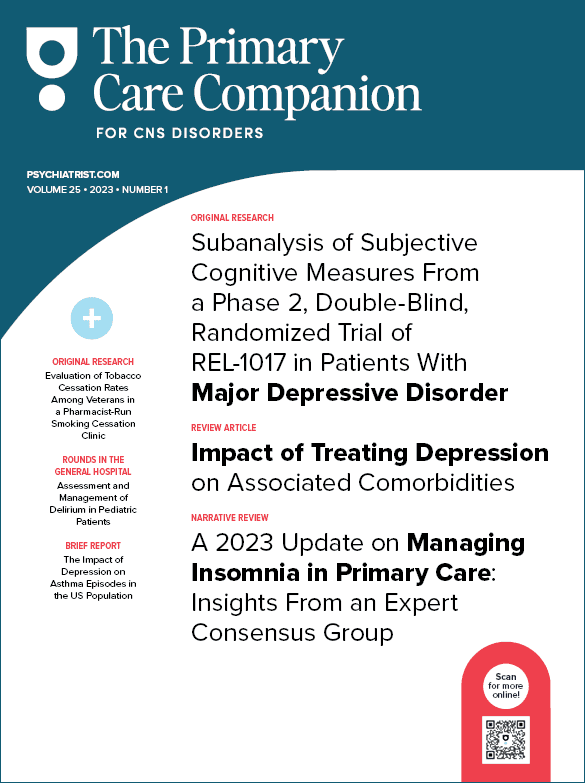There are few reports highlighting severe anxiety with psychosis in the pediatric population.1 However, it is important to note that around 27% of adolescent patients who have anxiety will also display psychosis.2 A case is presented of a 10-year-old boy with auditory and visual hallucinations in the context of long-standing anxiety, highlighting a unique phenomenon wherein symptoms persisted for years.
Case Report
The patient was a 10-year-old boy who presented to the outpatient clinic with his mother due to concerns of worsening anxiety, hearing voices, and seeing shadowy figures. Since he was 6 years old, he had seen “shadow man,” a tall unidentifiable figure. Shadow man appeared when the patient was alone. There were no known triggers for the patient’s hallucinations. Although the patient had witnessed domestic violence between his biological parents, his mother left his father years before he developed symptoms. His mother stated that the patient was never abused by his father, and family stated that the patient had no exposure to other traumas. His mother was aware of the symptoms; however, she believed it to be normal—an imaginary friend. The family did not seek medical care.
When the family moved to a new state, the boy’s symptoms significantly worsened. Shadow man was louder and told the patient to hurt his mother. His anxiety worsened in concert with shadow man’s increasing intrusion. A few months later, the patient refused to go to school, which prompted his family to bring him to the clinic.
The patient had no history of neurologic disorders or seizures. His mother denied any complications with pregnancy or major developmental delays, with no concerns for autism. He was attending a local elementary school in the third grade and had average grades, interacting well with teachers and friends.
Workup included the following: physical/neurologic examination, complete blood count, basic metabolic panel, urine toxicology screen, and magnetic resonance imaging of the brain. All test results were nonsignificant. Given the lack of concern for seizures, an electroencephalogram was not obtained. An autoimmune panel was not performed. The patient scored 18 on the 7-item Generalized Anxiety Disorder scale,3 indicating severe anxiety. A diagnosis of severe anxiety with psychotic features was made. The patient was started on aripiprazole. His hallucinations became “on and off,” but he developed blurry vision. He was switched to sertraline, and his vision improved, and the hallucinations decreased.
Discussion
Initial workup must rule out medical causes of psychosis: seizures, infections, autoimmune disorders, medications, and neoplasms. The history and clinical presentation ultimately dictated the team’s evaluation. Further extensive workup was not warranted, as the patient lacked focal neurologic deficits, exposures to toxins/substances, and fluctuating mental status.4 While autoimmune encephalitis was considered, the patient did not fit the disease course criteria and lacked other concerning symptoms; his anxiety and psychotic symptoms were chronic.5
Since the workup was negative, the team evaluated psychiatric causes. While posttraumatic stress disorder was considered, the patient did not satisfy the criteria,6 denying symptoms including intrusive memories of his father or avoiding reminders of past domestic violence. He denied that shadow man was his father. The timeline was a concern, as his symptoms worsened only after moving to a new state. Given that the patient was chronically anxious and that worsening fears about being alone and away from his caregiver worsened only after moving, anxiety with psychotic features was the preferrable diagnosis.
Cognitive-behavioral therapy is first-line treatment for anxiety in children; selective serotonin reuptake inhibitors are started when anxiety is severe.7 Due to prominent psychotic symptoms, the treatment team started aripiprazole, which has been shown to be well tolerated in children.8 However, he developed side effects, so the team decided to focus on treating the underlying cause of the psychosis: anxiety. Sertraline helped decrease the patient’s anxiety and psychosis. This case highlights how untreated anxiety can cause psychotic symptoms and that treatment of anxiety lessens the psychosis.
Article Information
Published Online: October 17, 2023. https://doi.org/10.4088/PCC.23cr03548
© 2023 Physicians Postgraduate Press, Inc.
Prim Care Companion CNS Disord 2023;25(5):23cr03548
Submitted: April 25, 2023; accepted June 30, 2023.
To Cite: Chang AN. Visual and auditory hallucinations in anxious preadolescent children. Prim Care Companion CNS Disord. 2023;25(5):23cr03548.
Author Affiliation: Department of Psychiatry, University of Hawaii, Honolulu.
Corresponding Author: Allison N. Chang, MD, Department of Psychiatry, University of Hawaii, 1356 Lusitana Street, 4th Floor, Honolulu, HI 96813 ([email protected]).
Relevant Financial Relationships: None.
Funding/Support: None.
Patient Consent: The patient and mother provided consent to publish the case report, and information has been de-identified to protect anonymity.
References (8)

- Pao M, Lohman C, Gracey D, et al. Visual, tactile, and phobic hallucinations: recognition and management in the emergency department. Pediatr Emerg Care. 2004;20(1):30–34. PubMed CrossRef
- Wigman JTW, van Nierop M, Vollebergh WA, et al. Evidence that psychotic symptoms are prevalent in disorders of anxiety and depression, impacting on illness onset, risk, and severity: implications for diagnosis and ultra-high risk research. Schizophr Bull. 2012;38(2):247–257. PubMed CrossRef
- Spitzer RL, Kroenke K, Williams JBW, et al. A brief measure for assessing generalized anxiety disorder: the GAD-7. Arch Intern Med. 2006;166(10):1092–1097. PubMed CrossRef
- McClellan J. Psychosis in children and adolescents. J Am Acad Child Adolesc Psychiatry. 2018;57(5):308–312. PubMed CrossRef
- Lancaster E. The diagnosis and treatment of autoimmune encephalitis. J Clin Neurol. 2016;12(1):1–13. PubMed CrossRef
- American Psychiatric Association. Diagnostic and Statistical Manual of Mental Disorders. Fifth Edition. American Psychiatric Publishing; 2013.
- Walkup JT, Albano AM, Piacentini J, et al. Cognitive behavioral therapy, sertraline, or a combination in childhood anxiety. N Engl J Med. 2008;359(26):2753–2766. PubMed CrossRef
- Kirino E. Efficacy and safety of aripiprazole in child and adolescent patients. Eur Child Adolesc Psychiatry. 2012;21(7):361–368. PubMed CrossRef
Enjoy free PDF downloads as part of your membership!
Save
Cite
Advertisement
GAM ID: sidebar-top




